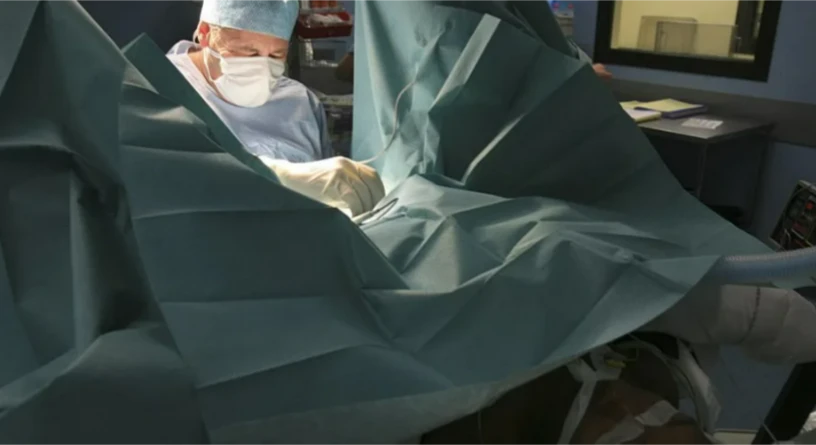Having a large clitoris is not a pathology, but a dysfunction within what is currently known as differences in sexual development (DSD).
The causes of this condition can vary, from genetic problems to hormonal disorders, such as the use of anabolic steroids.
Recently, the Assis Chateaubriand Maternity School, attached to the Hospital Complex of the Federal University of Ceará, in Brazil, performed two clitoroplasties, surgeries that seek to correct the clitoris.
María*, one of the operated patients, is 22 years old and BBC News Brazil spoke with her.
The woman said that she had been undergoing hormonal treatment at the hospital complex since December 2021 and complained to the medical team about the size of her clitoris, which increased even more during her sexual intercourse, something that made her feel extremely uncomfortable.
“When I started having sex, at the age of 18, I noticed that my clitoris swelled out of the ordinary. And that was something that bothered me a lot,” she related.

Looking for a solution
The young woman asked the gynecologist in one of her routine consultations if there was the possibility of reducing the size of the organ, since she had been suffering from this situation for years.
According to the doctors, Maria has a genetic condition that ended up causing hypertrophy (that is, abnormal growth) of the clitoris.
“Every day, [the organ] did not bother me, it felt normal, but during sexual intercourse, I looked at it and thought it was not normal. That’s why I wanted to reduce it,” explained the young woman, who added that her sexual partner never showed discomfort with the situation, although he advised her to seek treatment since she was indeed dissatisfied.
Since there was no specialist surgeon at the Ceará hospital, the procedure took a while.
Finally, on Christmas Eve, a specialist gynecologist from Sao Paulo agreed to travel the almost 3,000 kilometers from one town to the other to perform the surgery.
“The operation went very well and my recovery is going excellent. Now I feel like a complete woman, because it wasn’t normal for me before. For many people this is only a small problem, but for those who live with this it is difficult,” she said.
“Having an enlarged clitoris is a common developmental disorder, but it is not a disease,” explained Marcelo Praxedes Monteiro Filho, the gynecologist responsible for the surgeries and a doctoral student in Urology at the University of Sao Paulo (USP).
“There will be two months of recovery, but today I am a fulfilled woman and I will no longer be embarrassed during sexual intercourse,” added the patient.
What is clitoroplasty?
It is a surgery to reduce the size of the clitoris, but not its function.
After all, the organ has more than 8,000 nerve endings responsible, above all, for generating pleasure in the sexual act.
This organ, similar to a “little button”, varies in size from person to person.
Monteiro Filho listed some of the causes that cause this hypertrophy, known as clitoromegaly.
- Genetic alterations, which can be perceived from birth.
- Increased production of the group of male hormones (androgens).
- Use of anabolic steroids. Testosterone in its synthetic version, for example, is used to gain muscle mass faster. On the other hand, it produces an excess of masculinizing hormones.
- Use of hormones during pregnancy.
- Hormonal changes for various reasons.
- Tumors that increase the production of male hormones.
- In extreme cases polycystic ovary syndrome.
The expert explained that in polycystic ovarian syndrome (PCOS), for example, there is an increase in androgenic (male) hormones.
“PCOS is considered the most common endocrine disease in women of reproductive age. Its prevalence ranges from 5% to 17% in this age group. And it can cause menstrual irregularity, acne, excess body hair. And, in cases more severe, clitoral enlargement,” said Monteiro Filho.
The clitoris has tissues (corpora cavernosa) that fill with blood when there is arousal, causing it to increase in size naturally.
This is common in all women, but in the case of those with clitoromegaly it is further increased due to erectile tissue.
This can cause a larger than expected erection, causing discomfort during intercourse.
Also, according to experts, many women also do not feel comfortable wearing bikinis or very tight clothing, such as jeans, because the size of their private parts can attract attention.
“In surgery, we remove precisely those tissues that are enlarged, which are the corpora cavernosa. But we keep all the sensitive and vascular parts of the patient, which are the most important,” explained the gynecologist.
Does the clitoris have a defined size?
There is no standard clitoral size. Therefore, the ideal is to go to an expert when there really is visual or sexual discomfort.
The expert explained that in polycystic ovarian syndrome (PCOS), for example, there is an increase in androgenic (male) hormones.
“PCOS is considered the most common endocrine disease in women of reproductive age. Its prevalence ranges from 5% to 17% in this age group. And it can cause menstrual irregularity, acne, excess body hair. And, in cases more severe, clitoral enlargement,” said Monteiro Filho.
The clitoris has tissues (corpora cavernosa) that fill with blood when there is arousal, causing it to increase in size naturally.
This is common in all women, but in the case of those with clitoromegaly it is further increased due to erectile tissue.
This can cause a larger than expected erection, causing discomfort during intercourse.
Also, according to experts, many women also do not feel comfortable wearing bikinis or very tight clothing, such as jeans, because the size of their private parts can attract attention.
“In surgery, we remove precisely those tissues that are enlarged, which are the corpora cavernosa. But we keep all the sensitive and vascular parts of the patient, which are the most important,” explained the gynecologist.
Does the clitoris have a defined size?
There is no standard clitoral size. Therefore, the ideal is to go to an expert when there really is visual or sexual discomfort.
“The patient should not be measuring whether the clitoris is enlarged or not, because, in reality, this is a very personal issue. And if it is a little enlarged and she is satisfied, there is no problem,” the doctor advised.
However, there is a classification in the medical literature called Prader, which ranges numerically from 1 to 4 and is used to define the degree of physical abnormality of the genitalia.
This evaluation, however, can only be carried out by an expert.
Despite the fact that this condition affects a significant number of Brazilians in the country, surgical procedures to treat it are still not accessible.
*The name was changed to preserve the identity of the interviewee.

